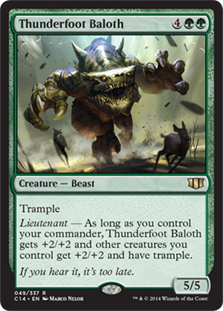Editor’s Note: This piece was originally designed to be a two part article series but was decided at the last minute to combine them instead. Hence why there was no Monday Magic segment on 12/1/14. Enjoy!
Commander 2014 has been released for weeks now, and the immediate reception appears to be largely positive. It would seem that the third time’s the charm, as this latest wave of original Commander product by Wizards of the Coast has found a happy medium between cost, effectiveness, and availability. Unlike previous years, all five decks are proving to be comparatively balanced with one another and are even decently holding their own against many player-made decks. Moreover, Wizards appears to be getting a better handle of demand, ensuring that their first wave of deck printings didn’t run into immediate shortage issues of last year.
In practical terms, this means that although things are still in flux, many stores are holding to the $35 MSRP, with the exception of the Red deck (due to genuine demand for it) and the White deck (which is largely due to people trying to make a buck off of Containment Priest). While we’ve stated before why you should never pay above MSRP in most cases, the early signs are certainly good sign to see. From the allure of planeswalker Commanders to healthy doses of infused nostalgia, this has been the smoothest rollout of the Commander supplements yet. The majority of the 61 new cards will even make fine additions to one EDH deck or another.
Longtime followers of this column may have noticed that you haven’t seen previous unique Commander cards on a Monday Magic segment. Nor are you likely to under normal circumstances. A few have asked as to why that is, and the answer is twofold. For one, the week-to-week segments mainly focus on cards that are older than the current block. Part of the fun of EDH is finding older cards and making them useful again, and that’s encouraged by highlighting ones more than a year or two old.
Secondly, it was decided early on to only include cards that come in normal sets, as outside of the game’s earliest expansions, normal sets are printed in far higher volume than supplemental product and therefore are easier to find cheaply (which is a selection criteria as well). While this excludes original cards coming from Commander sets, Planechase 2012, Portal Three Kingdoms, or random outliers like Mana Crypt, they also make up a very small percentage of the available card pool.
That said, many of the new Commander cards are pretty interesting, and it’d be a shame if they were ignored completely. So, this week we’re going to look at the ten most versatile cards in Commander 2014. Thus, the criteria for choosing them focuses around which cards can be utilized in the most situations and deck styles more so than those that are simply the most powerful or most valuable.
Anyhow, let’s get started!
Honorable Mention #1: Dualcaster Mage
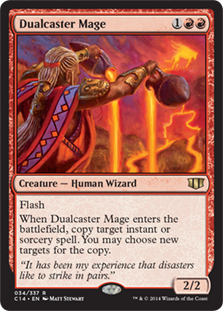 Dualcaster, a.k.a the next iteration of putting an existing low mana cost spell onto a small creature. (See Eternal Witness / Regrowth, Aether Adept / Unsummon, Reclamation Sage / Naturalize, etc.)
Dualcaster, a.k.a the next iteration of putting an existing low mana cost spell onto a small creature. (See Eternal Witness / Regrowth, Aether Adept / Unsummon, Reclamation Sage / Naturalize, etc.)
In this performance, Dualcaster Mage plays the part of Fork / Twincast / Reverberate as a creature-based copy spell, being dropped onto the battlefield copying whichever Instant or Sorcery spell you’re currently coveting.
For one more mana than its spell versions, Dualcaster then sticks around as a 2/2 creature for blocking or being fodder. It may not be the most original card going, but many players (and some in Wizards R&D) really like this ‘spell with legs’ mentality. Given the continued slew of Enter the Battlefield effects, this is something they’re clearly running with.
Honorable Mention #2: Freyalise, Llanowar’s Fury
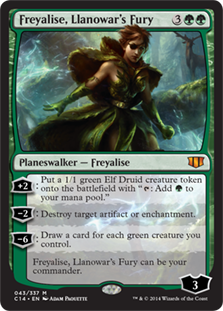 When players first realized that the long-famous Green planeswalker would be getting her own card, they were admittedly pretty excited. Once revealed, however, many felt that Freyalise The Card didn’t quite match up to Freyalise The Character. This was reinforced when Wizards admitted that they created the planeswalker templates first and then figured out which characters they could staple onto them. Alas, a shoehorn was made in this case.
When players first realized that the long-famous Green planeswalker would be getting her own card, they were admittedly pretty excited. Once revealed, however, many felt that Freyalise The Card didn’t quite match up to Freyalise The Character. This was reinforced when Wizards admitted that they created the planeswalker templates first and then figured out which characters they could staple onto them. Alas, a shoehorn was made in this case.
While Freyalise is largely considered to be one of the more lackluster planeswalker Commanders, she is still worth mentioning as a useful card in general. Her first ability not only makes Llanowar Elves in everything but name, but it also enables blocker protection.
Moreover, her second ability is a repeatable Naturalize, and her final ability – which is the only planeswalkers in this set that’s both repeatable and easy to achieve – is highly useful card draw for any color, let alone in Green. If anything, that fact that Feyalise isn’t all that intimidating works to your advantage of keeping her alive longer, regardless of whether she is used as a Commander or not.
Honorable Mention #3: Angel of the Dire Hour
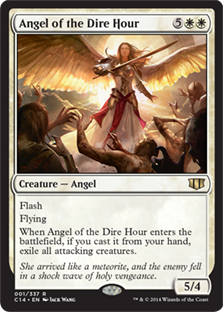 Angel of the Dire Hour is a particularly mean answer to an army of attackers that may include untargetable and / or indestructible creatures. Given the ever-growing volume of such creatures, it only makes sense that more exile effects such as this one start popping up too.
Angel of the Dire Hour is a particularly mean answer to an army of attackers that may include untargetable and / or indestructible creatures. Given the ever-growing volume of such creatures, it only makes sense that more exile effects such as this one start popping up too.
The only real drawback about Dire Hour is that it has to initially be used in a reactionary position to be of any real use. The card’s effect requires that you actually cast it, removing any chance of Cloudshift or Quicksilver Amulet shenanigans.
This means sitting on seven mana and then waiting for someone to attack with the army you wish to send into oblivion. When timed correctly, it often is a game-changing event that leaves you with a solid creature afterwards. If you’re unable to make use of that ability, though, she’s just a flashable 5/4 flyer for seven, which is far from ideal.
Number Ten: Domineering Will
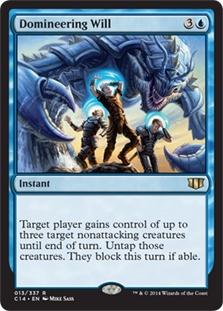 Domineering Will is the modern spiritual successor of Ray of Command and Reins of Power, allowing you to temporarily steal an opponent’s creatures. At first glance this is a weaker Ray of Command, with the restriction that the creatures you take must not be attacking, nor do they gain haste. Yet there is more to this card than it first appears. In exchange for not being able to steal an attacker it from combat, Domineering Will provides two different uses.
Domineering Will is the modern spiritual successor of Ray of Command and Reins of Power, allowing you to temporarily steal an opponent’s creatures. At first glance this is a weaker Ray of Command, with the restriction that the creatures you take must not be attacking, nor do they gain haste. Yet there is more to this card than it first appears. In exchange for not being able to steal an attacker it from combat, Domineering Will provides two different uses.
Firstly, it retains the classic option of borrowing other creatures to block an oncoming assault. This is useful if you enjoy the idea of stealing someone’s reserve / utility creatures and throwing them in the way. You’re also able to take any targetable creature on the battlefield, letting you use one player’s beatstick to fend off another. It’s win-win really.
Secondly, and more insidiously, is you can do the opposite. You don’t have to be the player that gets the borrowed creature trifecta. Domineering Will can have you throw the stolen creatures into combat and force them to block. Indeed, the politics of this card are as delicious as they are varied.
Number Nine: Unstable Obelisk
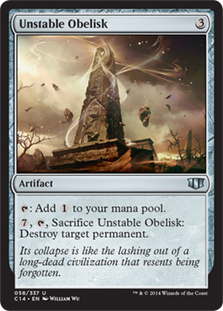 First of all, it’s good to see another obelisk in the game. There are far too few looming and forlorn obelisks in the game as it is (nine in all, six of which come from the Shards of Alara block), so this gets a flavor nod off the bat. Substantively speaking, though, Unstable Obelisk is also the perfect kind of unadorned-but-worthwhile card that EDH allows to shine.
First of all, it’s good to see another obelisk in the game. There are far too few looming and forlorn obelisks in the game as it is (nine in all, six of which come from the Shards of Alara block), so this gets a flavor nod off the bat. Substantively speaking, though, Unstable Obelisk is also the perfect kind of unadorned-but-worthwhile card that EDH allows to shine.
Most of the time, this card is going to be a mana producer. Costing three mana and tapping for one, this is on par with the Darksteel Ingots, Coalition Relics and Pristine Talismans of the world – not to mention the aforementioned Obelisk of Bant and its kin. Much like the Pristine Talisman, however, it does not generate colored mana, which admittedly means it’s best to be used in decks of two or less colors. Still, it’s alternate ability is worth the tradeoff.
In this case, it explodes.
Hey, it’s unstable for a reason.
Sure, its secondary ability is a one-time use, and it costs seven mana, but the ability to destroy almost any permanent is designed and enabled for late game use when a simple mana producer may not be as important as getting rid of your primary obstacle to victory. Plus, as cards like Spine of Ish Sah show, colorless permanent destruction is well worth the high mana investment – especially in colors that are not good at removing specific card types.
Number Eight: Siege Behemoth / Thunderfoot Baloth
Both of the creatures in this slot are incredibly close in purpose to one another, hence why they get a tie here. Either one of these big scary beasts is a fantastic enabler for creatures under your control, and if you have both out, at least one other player is about to get killed. Both Siege Behemoth and Thunderfoot Baloth maximize the amount of damage your army can do. Even if you lack a certifiable offense, you’re still left with a 7/4 hexproof ‘super trample’ on the one hand and a 5/5 trampler on the other. That’s without having anything else lending a hand, hoof, or claw to help them out.
The Siege Behemoth is the latest rendition of super trample, seen occasionally since it was first created back in, of all places, Portal Second Age, and the newest addition to the crew since Spinebiter. Super trample can be devastating to an opponent if you can dish out considerable amounts of damage, as even if they block you can still deal damage directly to them. Since Siege Behemoth is a 7/4 to begin with, you’re well on your way. At worst, this creature is a Thorn Elemental with hexproof. With an army at his back, however, he’s a repeatable Predatory Focus for a mere two mana more, making him suitable for major combat with even a handful of moderately sized creatures.
Thunderfoot Baloth takes a slightly different tact of how to take your head off. While all of Commander 2014’s five creatures with the Lieutenant ability buff themselves via having your Commander on the battlefield, only two of them also aid other creatures: Angelic Field Marshal bestows vigilance, whereas Thunderhoof grants +2/+2 and trample. For a mere one mana more, that’s a permanent near-Overrun just for the two creatures being out. This turns even the most benign 1/1 tokens into a dangerous array of 3/3 tramplers. Instantly. Plus, unlike Siege Behemoth, it doesn’t even need to attack to give the bonus.
No matter which one is leveraged, if you have a good number of creatures (as Green decks often do), either will up your board power substantially.
Number Seven: Ghoulcaller Gisa
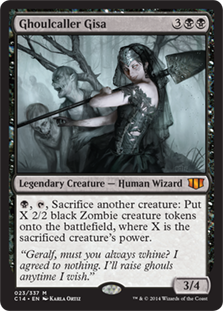 When it was apparent that the Innistrad block would not contain that the fan-favorite brother / sister necromancer duo as cards, there was understandable disappointment. Luckily, rather than waiting around until a return to that plane (assuming they’d even still be around), Gisa and Stitcher Geralf were added to the Commander sets.
When it was apparent that the Innistrad block would not contain that the fan-favorite brother / sister necromancer duo as cards, there was understandable disappointment. Luckily, rather than waiting around until a return to that plane (assuming they’d even still be around), Gisa and Stitcher Geralf were added to the Commander sets.
Unlike her brother though, who relies on deck combos (or mere luck) to get the best corpses in the neighborhood, Gisa is able to get her handy dirty as soon as she lands her first cadaver. In fact, that she requires another creature is her only real drawback.
Once you have your victim, there will almost always be a net gain from her easily activated ability. Even sacrificing one own 2/2 zombies yields two new ones, thereby always giving you more creatures than you started with. In a sense, she’s not unlike a Black hydra. And a zombie hydra sounds terrifying.
Things are only scaled upwards from there. Whether that means taking advantage of sacrifice / dying abilities, reanimating and sacrificing creatures for the hoard, or even just churning up an army from a heftier creature about to die anyhow, Gisa’s enables all sorts of play style options.
Number Six: Comeuppance
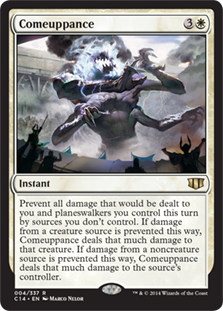 Comeuppance takes an already established card trope and turns its effect up to 11 by combining the usefulness of nullifying creature-based damage (a la Ethereal Haze) and spell-based damage (such as Reverse Damage) into one. The effect of preventing damage and throwing it back at the controller is seen both in monowhite (i.e. Honorable Passage, Divine Deflection), and in Red/White cards, via Reflect Damage, and more recently, with Deflecting Palm.
Comeuppance takes an already established card trope and turns its effect up to 11 by combining the usefulness of nullifying creature-based damage (a la Ethereal Haze) and spell-based damage (such as Reverse Damage) into one. The effect of preventing damage and throwing it back at the controller is seen both in monowhite (i.e. Honorable Passage, Divine Deflection), and in Red/White cards, via Reflect Damage, and more recently, with Deflecting Palm.
However, most damage reflection is relegated to a single source. Comeuppance handles multiple ones – making it incredibly handy in the right circumstances. Not only can it send a sizable burn spell back into the caster’s face, but if used as combat prevention it’s likely to destroy most creatures heading your way. For a mere four mana, this can easily rout your aggressor, and, ideally, swing the board advantage in your favor. At worst, it’s a Holy Day. More often, though, it’s either going to be significant creature removal, or a potential death sentence.
Number Five: Wave of Vitriol
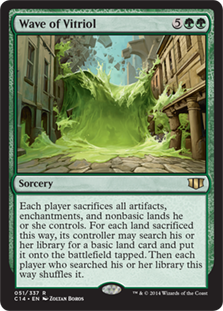 Green has always been known as a color keen on destroying artifacts and enchantments – things that it sees as antithetical to the natural order.
Green has always been known as a color keen on destroying artifacts and enchantments – things that it sees as antithetical to the natural order.
What most may not realize is that although it’s had Tranquility for mass enchantment removal and Seeds of Innocence for mass artifact removal since the very early days of Magic, only two monogreen cards exist destroy both en masse. And it took until 2013. One card was last year’s Bane of Progress. The other is this one.
While a costly spell, this card is a potent tide-changer against defensive or combo-heavy opponents, and it can be easily leveraged in almost any Green deck. Wave of Vitriol takes aim at noncreature permanents in force, and it’s highly effective at doing so. Rather than trying to merely destroy artifacts and enchantments, players must sacrifice them instead – ensuring it catches even indestructible cards.
Wave of Vitriol also takes a page out of Red’s book by splicing in From the Ashes, making players swap nonbasic lands for basic ones. Depending on the volume of nonbasic lands your meta group uses, this could be a minor card addition, or it could be equally as damaging as its other cleansing powers. Either way, this wave is highly useful at clearing the board in Green, breaking upon the table with naturalist fervor.
Number Four: Feldon of the Third Path
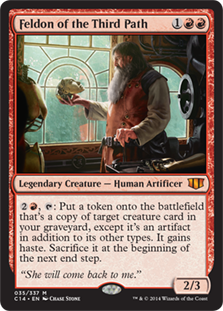 For longtime players of the game, few new cards generated more fanfare than this one. Feldon was a character originating in Antiquities, but he was only ever referenced in-game once, via Feldon’s Cane, and then later out of game through a short story. Almost 20 years later, he’s finally gained his own card; it may have been worth the wait.
For longtime players of the game, few new cards generated more fanfare than this one. Feldon was a character originating in Antiquities, but he was only ever referenced in-game once, via Feldon’s Cane, and then later out of game through a short story. Almost 20 years later, he’s finally gained his own card; it may have been worth the wait.
Feldon of the Third Path in many ways is an inverse Sneak Attack, temporarily returning any creature in your graveyard as an artifact creature, and like Gisa, the one limitation he has is that he requires creatures in the graveyard to be fully utilized.
Outside of the obvious synergy Feldon has with artifact-based strategies and combos, this card is equally as useful outside of those settings. Whether it’s routinely copying a dead creature for a potent Enter the Battlefield or activated ability, using its copy to attack with impunity, or making an extra blocker if on the defensive, Feldon’s Mimic Vat-like uses are as varied as they are efficient. With modest casting and ability costs, this is the type of card that allows Red to flex its color abilities in ways beyond goblins, dragons, and Lightning Bolts, and this old tinkerer can find use in almost any deck with even a moderate amount of creatures.
Number Three: Containment Priest
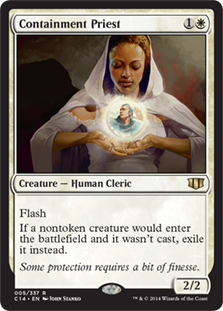 Last year’s debacle with certain Commander deck scarcity was fueled mostly by Legacy players wanting to get their hands on True-Name Nemesis and people who eagerly wanted to sell it to them for a tidy sum.
Last year’s debacle with certain Commander deck scarcity was fueled mostly by Legacy players wanting to get their hands on True-Name Nemesis and people who eagerly wanted to sell it to them for a tidy sum.
Indeed, supplemental products are a means now for Wizards of the Coast to get Legacy-playable cards into use while sidestepping adding them to their precious Standard and Modern formats. The bone being throne to Legacy this cycle is Containment Priest.
Undoubtedly, this card is popular for a reason. For just two mana, this seemingly simple cleric disrupts the disproportionate number of ways people try to cheat nontoken creatures into play.
Reanimation, flickering, abusing cards like Flash that drop creatures directly onto the battlefield, the unearth ability, the persist ability, Commanders like Kaalia of the Vast – this stops all of them.
Oh, and she also has flash, providing the bonus element of surprise.
Then, on top of that, her replacement effect ensures that creatures are immediately exiled, never seeing the board. Much like Angel of the Dire Hour, this card insists that you actually cast your creatures. (The horror!) There are not a lot of cheap 2/2 creatures that can singularly shut down whole deck strategies, but this is one of them. Between her deceptively powerful ability and low casting cost, Containment Priest is a fantastic addition to any White deck that wants everyone to play by the rules when it comes to summoning creatures.
Number Two: Arcane Lighthouse
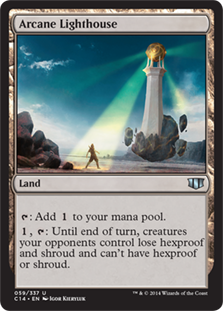 Few things frustrate players more when something happening one can respond to. From uncounterable life loss to being spell-locked due to Iona, Shield of Emeria to being unable to readily destroy anything a player has because of Avacyn, Angel of Hope, things can happen where some – or all – players lack the ability to counteract the machinations of an opponent. Abusing hexproof is yet another example of this, as cards like Uril, the Miststalker and Asceticism often illustrate.
Few things frustrate players more when something happening one can respond to. From uncounterable life loss to being spell-locked due to Iona, Shield of Emeria to being unable to readily destroy anything a player has because of Avacyn, Angel of Hope, things can happen where some – or all – players lack the ability to counteract the machinations of an opponent. Abusing hexproof is yet another example of this, as cards like Uril, the Miststalker and Asceticism often illustrate.
Arcane Lighthouse answers the lattermost case. Although not as consistently impactful or powerful as other Commander 2014 cards, this dutiful little one is not to be underestimated. There are few answers for a hexproofed army besides a board wipe or the occasional Sudden Spoiling / Polymorphist’s Jest effects. The only card to specifically address hexproof is Glaring Spotlight, but that only allows you to affect them and requires you use a valuable card slot for it.
This does the the same job in land form, solving the slotting problem, and making it less susceptible to removal. What’s more, it also fixes the exclusivity problem of the Spotlight, providing everyone the ability to target problematic creatures while adding a degree of political favorability as well.
Arcane Lighthouse, like any lighthouse, serves a quiet but important role in the game, and this card can into slide into almost any EDH deck without wasting space. It may not win you games, but it is the perfect answer to its not-so-unique problem; you’ll be glad it’s there should the need arise.
Number One: Song of the Dryads
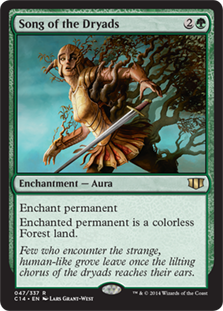 Some can argue that Song of the Dryads is a bit of a color pie violation – Magic R&D’s Mark Rosewater certainly thinks so – based on the philosophical notion that modern Green isn’t supposed to be able to answer creature threats except by other creatures.
Some can argue that Song of the Dryads is a bit of a color pie violation – Magic R&D’s Mark Rosewater certainly thinks so – based on the philosophical notion that modern Green isn’t supposed to be able to answer creature threats except by other creatures.
Regardless of whether you subscribe to that notion or not, Song of the Dryads is easily one of the most talked about cards of Commander 2014, and with good reason. Essentially a Green offspring of Oblivion Ring and Lignify, there is simply no more versatile card in this batch.
There are a few key differences between this card and O-Ring that make it even more potent, however. For starters, the Song can affect lands, creating a flavorful means of hosing a pesky land without actually destroying it.
Far more importantly is that unlike Oblivion Ring, the permanent is not removed from the battlefield. This is especially pertinent if, say, used on an opposing Commander. Just like Darksteel Mutation, the lure of the Song means it can’t retreat to the safety of the Command Zone. For most players, being able to throw a Commander, planeswalker, or other problematic permanent into limbo is easily worth the tradeoff of someone having an extra mana.
Hey, it works for Path to Exile.
In any case, this is one card that can be used in any Green deck and against any targetable permanent, meaning that almost nothing on the battlefield is safe from the Song of the Dryads.
![]()
Would these cards have been on your own top ten? Tell us over on our social media!
Do you have a particular Commander card to suggest for us to shine a future Spotlight on? You can send suggestions to ryan@cardboardrepublic.com


